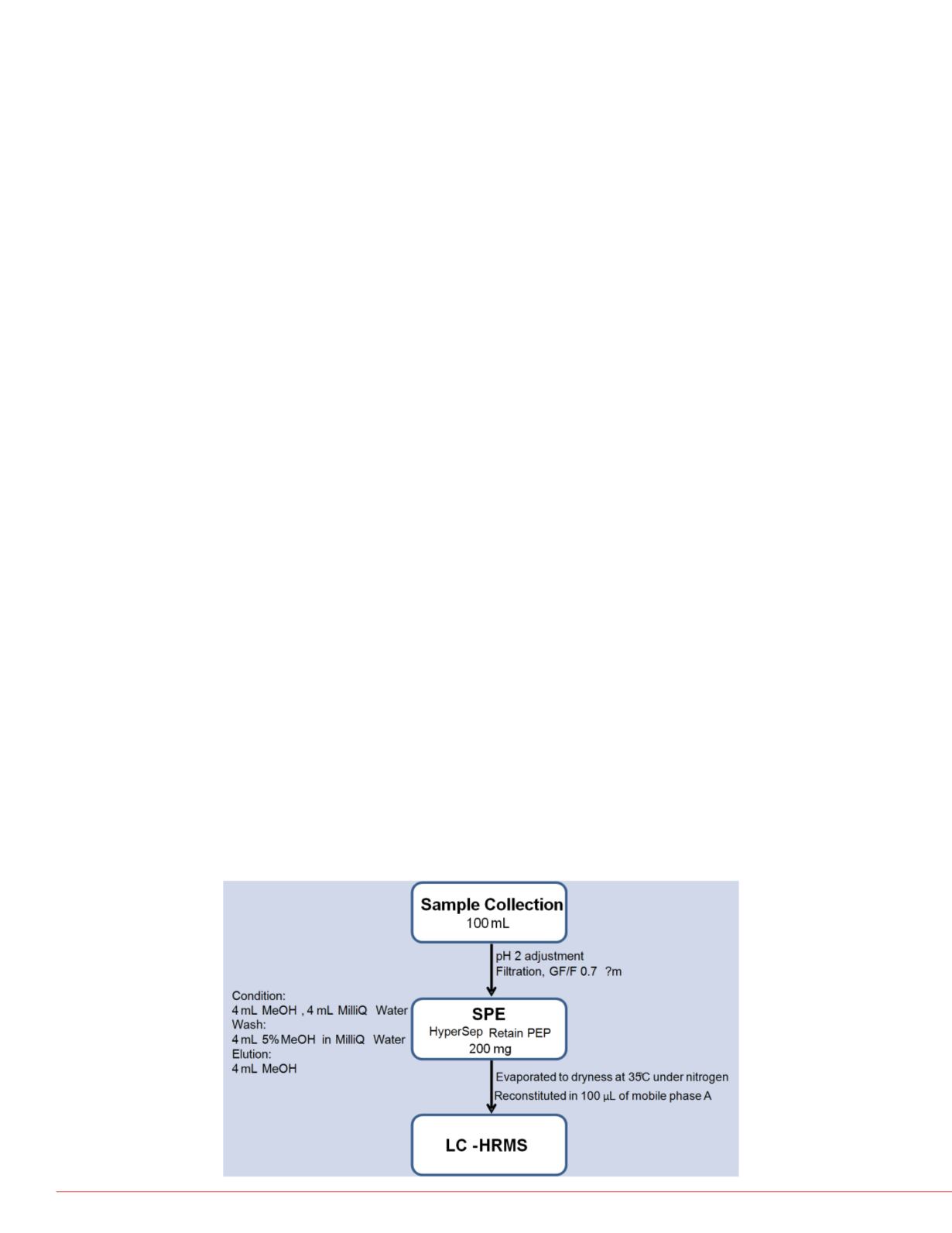

2
Optimizing a Generic Approach to Analyzing PPCPs in River Water Kelly
Introduction
The occurrence of pharmaceutically-related contaminants
within the environment continues to be a research area which
generates great interest. The full environmental effects of
chronic exposure of such pollutants have yet to be fully
understood. As such more knowledge is sought on the
presence of these contaminants within the environment.
Traditionally, a targeted multi-residue analytical approach is
applied to the analysis of environmental waters. A consequence
of this can be a somewhat limited estimation of the true breadth
of occurrence of pharmaceutically-related drug residues within
such waters. Recent advances have seen non-targeted
methods proposed as valid alternatives to the traditional
approach.
A ‘semi
-
targeted’ analytical approach is presented herein for
the detection of a range of over-the-counter, prescribed and
illicit drugs in environmental waters using mixed mode solid
phase extraction (SPE) and liquid chromatography-high
resolution mass spectrometry (LC-HRMS). The potential to
perform retrospective non-target analysis is also presented.
Experimental
A broad analytical screening method, shown in Figure 1, was
developed using a selection of structurally diverse species
which represented a variety of compounds classes, functional
groups, p
K
a
and log
P
values as well as reported environmental
occurrences.
FIGURE 1. Schematic showing developed semi-
targeted analytical approach.
Results
1. SPE Me
The recoveri
different SP
Figure 2 sho
majority of c
PEP-functio
a 100 mL sa
2
. ‘Semi
-
T
The develop
analysis of b
wastewater.
comparison
presence of
FIGURE 2. A
DVB sorbent
sorbent (CX)
0
50
100
150
Salicylic Acid
Caffeine
SMX
SMZ
%AbsoluteRecovery
FIGURE 3.
AA: Peak A
accurate m
The occurrence of pharmaceutically-related contaminants
within the environment continues to be a research area which
generates great interest. Th full environmental effects of
chro ic xposure of su h poll tan s have yet to be fully
understood. As such more knowledge is sought on the
presenc of these contaminants within the nvironment.
Traditionally, a targeted multi-residue analytical approach is
applied to the analysis of environmental waters. A consequence
of this can be a somewhat limited estimation of the true breadth
of occurrenc of pharmac utically-related drug residues within
suc waters. Recent adv nces have seen on-targeted
methods prop sed s v lid alternatives to the traditional
approach.
A ‘semi
-
targeted’ analytical approach is presented herein for
the detection of a range of over-the-counter, prescribed and
illicit drugs in environmental waters using mixed mode solid
phas x raction (SPE) and liquid chromatography-high
resolution mass spectrometry (LC-HRMS). Th potential to
erform retrospective non-target analysis is also presented.
Experimental
A broad analytical screening method, shown in Figure 1, was
developed using a selection of structurally diverse species
which represented a variety of compounds classes, functional
groups, p
K
a
and log
P
values as well as reporte environm ntal
occurrences.
FIGURE 1. Schematic showing developed semi-
targeted analytical approach.
1. SPE Me
The recoveri
different SP
Figur 2 sho
majority of c
PEP-functio
a 100 mL sa
2
. ‘Semi
-
T
The develop
analysis of b
wastewater.
comparis n
pre nce of
FIGURE 2. A
DVB sorbent
sorbent (CX)
0
50
100
150
Sal cylic Acid
Caffeine
SMX
SMZ
%AbsoluteRecovery
FIGURE 3.
AA: Peak A
accurate m
100
The occurrence of pharmaceutically-related contaminants
within the environme t continues to be a research area which
generates great interest. The full environmental effects of
chronic exposure f such p llutants have yet to be fully
understood. As such more knowledge is sought on th
presence of these contaminants within the environment.
Traditionally, a targeted multi-residue analytical approach is
applied to the analysis of environmental waters. A consequence
of this can be a somewhat limited estimation of the true breadth
of occurrence of ph rmaceutically-related drug residues within
such waters. R cent advances have seen non-targeted
methods proposed as valid alternatives to the traditional
approach.
A ‘semi
-
targeted’ analytical approach is presented herein for
the detection of a range of over-the-counter, prescribed and
illicit drugs in environmen al w ters using mixed mo e solid
phase extraction (SPE) and liquid c romatography-high
resolution mass spectrometry (LC-HRMS). The potential to
perform retrospective non-target analysis is also presented.
Experimental
A broad analytical screening method, shown in Figure 1, was
developed using a selection of structurally diverse species
which represented a variety of comp unds classes, functional
groups, p
K
a
and lo
P
values as well as reported environmental
occurrences.
FIGURE 1. Schematic showing developed semi-
targeted analytical approach.
1. SPE Meth
The recoveries
different SPE s
Figure 2 shows
majority of com
PEP-f nctionali
a 100 mL samp
2
. ‘Semi
-
Tar
The dev loped
analysis of both
wastewater. Th
comparison wit
presence of co
FIGURE 2. Abs
DVB sorben (
sorbent (CX) w
0
50
100
150
Salicylic Acid
Caffeine
SMX
SMZ
%AbsoluteRecovery
FIGURE 3. Co
AA: Peak Are
accurate mas
0
50
100
t
R
:
A :
AH:
BP:



















